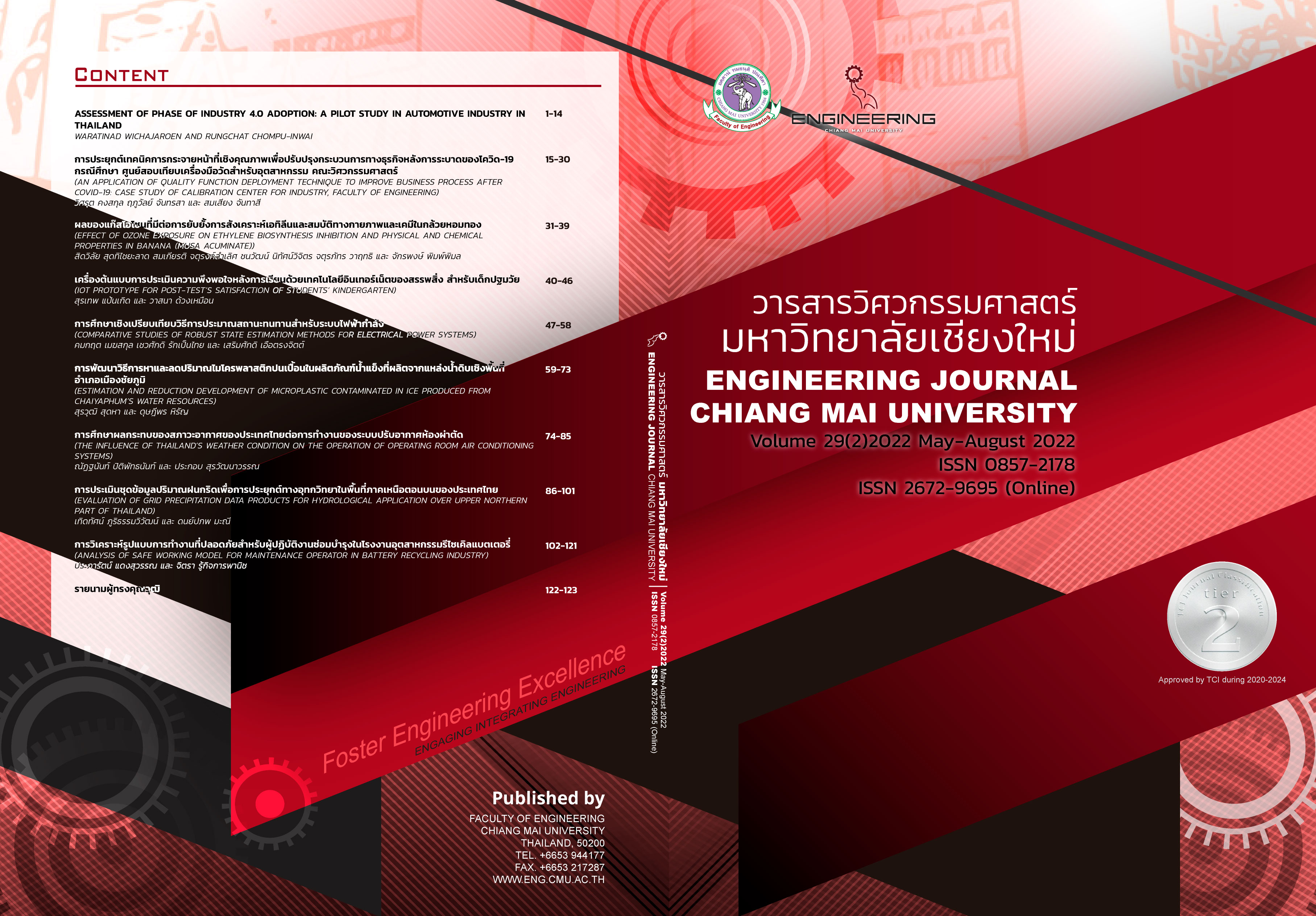Estimation and Reduction Development of Microplastic Contaminated in Ice Produced from Chaiyaphum’s Water Resources
Keywords:
Microplastic, Contaminate, Ice, Product, Water ResourceAbstract
The objective of this research is to find microplastics contaminated in ice products for consumption. A case study was ice-produced in Muang Chaiyaphum district. There are 5 manufacturers in total. The samples are divided into 3 groups: group 1 water samples from raw water used for ice production, group 2 ice samples produced directly from operators, and group 3 ice samples that are distributed by random. The researcher collected the samples from December 2021 to April 2022 and brought them into the analytical process by selecting methods and standards according to the methods of Masura, Baker, Foster, Arthur, & Herring (2015) [14] that constructed as a specialized manual for NOAA. And the methods developed by Kanokwan Netsingsaeng (Naresuan University, 2020) [1]. To analysis categories were quantity, color, morphology and size of microplastics compared to 1 liter of water sample. The results showed that the average amount of microplastics in group 1 was 224 pieces, group 2 was 28 pieces, group 3 was 323 pieces. Microplastics color was found in Group 1 were 232 black, and 33 russet, in group 2 were 23 black and 5 russet, and group 3 were 310 black and 14 mean russet. Microplastic morphology was found that Group 1 were 201 fragments, 19 fibers and 4 films, Group 2 were 27 fragments, 1 fiber and 1 film, Group 3 were 306 fragments, 11 fibers and 7 films. The size of most microplastics is smaller than 1,000 micrometers, with only 0.005% found larger. The conclusion is the amount of microplastics in ice found 28 pcs/L was less contaminated compared to the Niall McCarthy (2018) average of 325 pcs/L [11]. The highest levels of microplastics were the Group 3 which is beyond this research and needs to study the factors affecting in the future. Innovative developments to reduce the amount of ice packaging materials can be changed from plastic sacks to waterproof fabrics. But still not worth the cost at present. and further study of the factors that affect it in the future.
References
กนกวรรณ เนตรสิงแสง. (2563). การปนเปื้อนไมโครพลาสติก และปลาในพื้นที่ชุ่มน้ำบึงบอระเพ็ด จังหวัดนครสวรรค์. วิทยานิพนธ์ วิทยาศาสตรมหาบัณฑิต, สาขาวิทยาศาสตร์สิ่งแวดล้อม, มหาวิทยาลัยนเรศวร.
กรณิศ ตันอังสนากุล. (16 ตุลาคม 2560). ทางออกของขยะที่มองไม่เห็น . สืบค้นเมื่อ 15 เมษายน 2561, จาก
https://www.the101.world/life/solution-from-microplasticpollution/
กรมควบคุมมลพิษ. (2546). คู่มือการติดตามตรวจสอบและประเมิน คุณภาพน้ำในแหล่งน้ำจืดผิว ดิน. กรุงเทพฯ: ชุมนุมสหกรณ์การเกษตรแห่งประเทศไทย จำกัด.
กรมควบคุมมลพิษ. (2561). รายงานสถานการณ์มลพิษของประเทศไทย ปี 2560. กรุงเทพฯ: บริษัท วงศ์สว่างพับลิชชิ่ง แอนด์ พริ้นติ้ง จ้ากัด
เกรียงศักดิ์ วงศ์พร้อมรัตน์. (2556). รอบรู้เรื่องพลาสติก. กรุงเทพฯ: อุตสาหกรรมพัฒนามูลนิธิ สถาบันพลาสติก.
ทานตวรรณ เต็กชื่น, นิรันดร์ จันรัสมี และอดิศักดิ์ แก้วใส. (2544). พลาสติก 1. กรุงเทพฯ: สกายบุ๊กส์.
บุษยมาส พิมพ์พรรณชาติ. (2554). ดัชนีคุณภาพน้ำ. วารสารวิทยาศาสตร์ลาดกระบัง, 20(1), 70- 82.
ปิติพงษ์ ธาระมนต์, สุหทัย ไพรสานฑ์กุล และนภาพร เลียดประถม. (2559). การปนเปื้อนของ ไมโครพลาสติกในหอยสองฝาบริเวณชายหาดเจ้าหลาวและชายหาดคุ้งวิมาน จังหวัด จันทบุรี. วารสารแก่นเกษตร 44 (ฉบับพิเศษ 1), 738-744.
พรรษวรรณ ศรีนาค. (2547). การควบคุมมลพิษทางน้ำ. กรุงเทพฯ: มีนเซอร์วิส ซัพพลาย.
ศีลาวุธ ดำรงศิริ. (2562). ไมโครพลาสติกในแหล่งน้ำจืดและแหล่งน้ำเพื่อการอุปโภคบริโภค. วารสารสิ่งแวดล้อม, ปีที่ 23 (ฉบับที่ 2).
Baldwin, A. K., Corsi, S. R., and Mason, S. A. (2016). Plastic debris in 29 Great Lakes tributaries: relations to watershed attributes and hydrology. Environmental Science & Technology, 50(19), 10377-10385.
Cable, R. N., Beletsky, D., Beletsky, R., Wigginton, K., Locke, B. W., & Duhaime, M. B. (2017). Distribution and modeled transport of plastic pollution in the Great Lakes, the world's largest freshwater resource. Frontiers in Environmental Science, 5, 45.
Cole, M., Lindeque, P., Halsband, C., and Galloway, T. S. (2011). Microplastics as contaminants in the marine environment: a review. Marine pollution bulletin, 62(12), 2588-2597.
CounterMEASURE project. (2020). Survey on Microplastic Leakage in the Mekong River Basin. Retrieved August 23, 2020, from https://3d7e7899-1117-43cb-9194- 3f1feb5a407b.filesusr.com/ugd/d5ac80_a71e87593bb647f3aa2fcd8bd4559cf 3.pdf
Dris, R., Imhof, H. K., Löder, M. G., Gasperi, J., Laforsch, C., & Tassin, B. (2018). Microplastic contamination in freshwater systems: methodological challenges, occurrence and sources. In Microplastic Contamination in Aquatic Environments (pp. 51-93). Elsevier.
Lahens, L., Strady, E., Kieu-Le, T. C., Dris, R., Boukerma, K., Rinnert, E., ... & Tassin, B. (2018). Macroplastic and microplastic contamination assessment of a tropical river (Saigon River, Vietnam) transversed by a developing megacity. Environmental Pollution, 236, 661-671.
Masura, J., Baker, J. E., Foster, G. D., Arthur, C., & Herring, C. (2015). Laboratory methods for the analysis of microplastics in the marine environment: recommendations for quantifying synthetic particles in waters and sediments.
Su, L., Xue, Y., Li, L., Yang, D., Kolandhasamy, P., Li, D., & Shi, H. (2016). Microplastics in Taihu Lake, China. Environmental Pollution, 216, 711-719.
Downloads
Published
Issue
Section
License
ลิขสิทธิ์ของบทความที่ตีพิมพ์ในวารสารฉบับนี้จะยังเป็นของผู้แต่งและยินยอมให้สิทธิ์เผยแพร่กับทางวารสาร
การเผยแพร่ในระบบวารสารแบบเปิดนี้ บทความจะสามารถนำไปใช้ได้ฟรีในการศึกษา และในทางที่ไม่เกี่ยวกับการค้า




